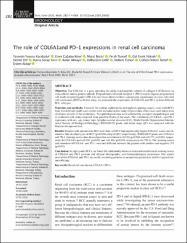| dc.contributor.author | Karabulut, Yasemin Yuyucu | |
| dc.contributor.author | Köse, Emre Cagatay | |
| dc.contributor.author | Bozlu, Murat | |
| dc.contributor.author | Tuncel, Ferah | |
| dc.contributor.author | Yüksek, Gui Emek | |
| dc.contributor.author | Etit, Demet | |
| dc.contributor.author | Akbay, Erdem | |
| dc.contributor.author | Öznur, Meltem | |
| dc.date.accessioned | 2022-05-11T14:36:55Z | |
| dc.date.available | 2022-05-11T14:36:55Z | |
| dc.date.issued | 2020 | |
| dc.identifier.issn | 2149-3235 | |
| dc.identifier.issn | 2149-3057 | |
| dc.identifier.uri | https://doi.org/10.5152/tud.2020.20062 | |
| dc.identifier.uri | https://hdl.handle.net/20.500.11776/8484 | |
| dc.description.abstract | Objective: The COL6A1 is a gene encoding the alpha 1 polypeptide subunit of collagen 6 (COL6A1), an extracellular matrix protein subunit. Programmed cell death receptor-1 (PD-1) and its ligand, programmed cell death receptor ligand-1 (PD-L1) have been shown to have a prognostic significance in clear cell renal cell carcinomas (RCCs). In this study, we evaluated the expressions of COL6A1 and PD-1 in four different RCC subtypes. Materials and methods: A total of 161 radical nephrectomy and nephron-sparing surgery cases with Ra7s from five different health care centers were included in this study. Clinical data of the cases were taken from electronic records of the institutions. The pathological data were collected by an expert uropathologist and re-evaluated with slides obtained from paraffin blocks of the cases. The correlation of COL6A1 and PD-1 expression with sex, age, tumor type, lymphovascular invasion (LVI), World Health Organization/International Society of Urological Pathology (WHO/ISUP) grade, and tumor stage (pT) was analyzed with the Pearson chi-squared test. Results: Patients with sarcomatoid RCC and clear cell RCC had significantly higher COL6A1 scores and intensities than in other types of RCC (p=0.004 and p=0.002, respectively). WHO/ISUP grade and, COL6A1 and PD-1 staining scores also showed positive correlation (r=0.230, p=0.004 and r=0.277, p=0.001, respectively for COL6A1 and r=0.191, p=0.018 and r=0.166, p=0.041, respectively for PD-1). The staining scores and intensities of COL6A1 and PD-1 were not different between the patients with positive and negative LVI (p>0.05). Conclusion: In high-grade RCCs, we found the relationship between immunohistochemical staining scores of COL6A1 and PD-1 proteins and clinical, demographic, and histopathological parameters. Our results proved that COL6A1 and PD-1 are really promising proteins as prognostic parameters and for targeted immunotherapy. | en_US |
| dc.description.sponsorship | Mersin UniversityMersin University [2017-2-AP3-2425] | en_US |
| dc.description.sponsorship | The authors declared that this study has received Mersin University Scientific Research Projects project, AP3; 2017-2-AP3-2425 as financial support. | en_US |
| dc.language.iso | eng | en_US |
| dc.publisher | Aves | en_US |
| dc.identifier.doi | 10.5152/tud.2020.20062 | |
| dc.rights | info:eu-repo/semantics/openAccess | en_US |
| dc.subject | Renal cell carcinoma | en_US |
| dc.subject | COL6A1 | en_US |
| dc.subject | PD-1 | en_US |
| dc.subject | Poor-Prognosis | en_US |
| dc.subject | System | en_US |
| dc.title | The role of COL6A1and PD-1 expressions in renal cell carcinoma | en_US |
| dc.type | article | en_US |
| dc.relation.ispartof | Turkish Journal of Urology | en_US |
| dc.department | Fakülteler, Tıp Fakültesi, Cerrahi Tıp Bilimleri Bölümü, Tıbbi Patoloji Ana Bilim Dalı | en_US |
| dc.identifier.volume | 46 | en_US |
| dc.identifier.issue | 4 | en_US |
| dc.identifier.startpage | 282 | en_US |
| dc.identifier.endpage | 287 | en_US |
| dc.institutionauthor | Öznur, Meltem | |
| dc.relation.publicationcategory | Makale - Uluslararası Hakemli Dergi - Kurum Öğretim Elemanı | en_US |
| dc.authorscopusid | 55655819700 | |
| dc.authorscopusid | 57218104783 | |
| dc.authorscopusid | 6701432632 | |
| dc.authorscopusid | 55799070700 | |
| dc.authorscopusid | 57210859841 | |
| dc.authorscopusid | 6507796024 | |
| dc.authorscopusid | 56461231100 | |
| dc.identifier.wos | WOS:000550781400015 | en_US |
| dc.identifier.scopus | 2-s2.0-85087896380 | en_US |
| dc.identifier.pmid | 32479254 | en_US |



















